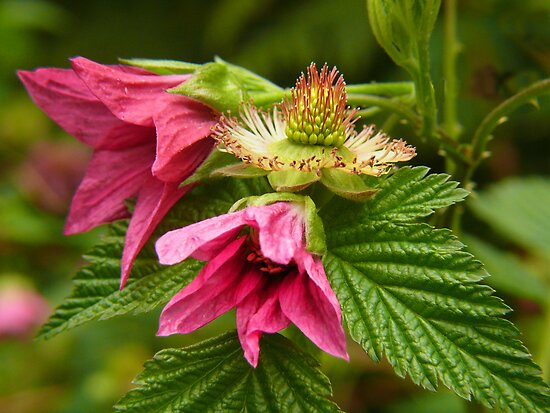RED HUCKLEBERRY Vaccinium
parvifolium
Species Description
The Red
Huckleberry is an upright, finely branched deciduous shrub native to the Pacific
Northwest. It can reach heights of 12 feet and 5 feet wide. The leaves are
arranged alternately on the stems and are very thin and elliptical in shape. The
leaves are also simple with entire margins. Each leaf is approximately .5-1.5
inches long. The leaves are dark on the top side and pale on the bottom side.
The branches are smooth, green and have a broom-like branching habit [2].
Flowers are
solitary and are produced on the lowest leaves of the youngest shoots. The
flowers are small, pale and waxy. The flowers are about .25 inches long and
are either greenish white or pinkish. The flowers are also bell shaped like
most other members of the Ericaceae family. The fruit is globose and vibrant red
in color and just over .25 inches in diameter. They are edible [3].
Reproduction is
both sexual and vegetative. The can sprout from branches, stems, or rhizomes.
They tend to be more effective vegetatively, rather than sexual reproduction.
Many suffer from inbreeding depression and self-incompatibility during
self-pollination [4].
|
Species Ecology
It can be found
from Alaska to California and on both sides of the Cascades, but is more
popular on the west side. Moist woods from sea-level to mid-elevations are
best suitable for the red huckleberry. It is adapted for acidic soil and full
to partial shade [2]. It is usually found growing out of rotten stumps. It
does not tolerate root disturbance. It is a common understory plant found in
coniferous forests [4]. It grows in association with salmonberry, salal,
thimbleberry, blackberry, oak fern, lady fern, and dwarf Oregon grape.
The berries are
edible and are very attractive to birds. Birds are the presumed vectors for
seed dispersal. Grouse, Robins, Swainson’s Thrushes, Cedar Waxwings, Spotted
Towhees, and Band-Tailed Pigeons are commonly found eating the fruit.
Squirrels, chipmunks, mice, raccoons, foxes, and bears also partake in these
berries. It is an important plant to Deer and elk, who eat the branches in
the winter time [4]. The digestive processes of animals may promote
germination [5].
|
Ethnobiology
The huckleberry
is common as an ornamental plant. Coastal native American tribes foraged for
the fruit when Europeans first came upon the pacific Northwest [2]. They
would be consumed in large quantities and used as bait in fishing. Berries
were often stewed and made into sauces and eaten at winter feasts. The bark
contains an acid called Quinic acid, which was used as a cold remedy. The
taste of the berry is described as good but tart/sour. They contain a high
amount of vitamin C [5].
|
References
[1] http://plants.usda.gov/core/profile?symbol=vapa
[2] http://www.pnwplants.wsu.edu/PlantDisplay.aspx?PlantID=532
[3] http://dendro.cnre.vt.edu/dendrology/syllabus/factsheet.cfm?ID=448
[4] http://www.pugetsound.edu/academics/academic-resources/slater-museum/exhibits/terrestrial-panel/red-huckleberry/
[5] http://www.fs.fed.us/database/feis/plants/shrub/vacpar/all.html
|
SALMONBERRY Rubus
spectabilis
Species Description
This is a deciduous shrub from the Rosaceae family.
It can grow to a height of 10 feet and spread out in thick stands. The leaves
are alternate and pinnately compound. The leaflets are ovate, 1-3 inches
long, and have lobes as well as doubly serrate margins. They are green on
both the top and bottom sides. The upper leaf surface is wrinkly and the
lower surface is prickly. Stems are green with thorns, and older branches are
orange and flaky with a few prickles [2].
The flowers are
monoecious, perfect, complete, and relatively large (1.5 inches in diameter)
[2]. They can either appear in clusters or singly and are bright pink/magenta
to dark red in color. The fruits are yellow/red (salmon colored). They are
aggregates of drupelets and resemble raspberries [4].
They can
reproduce sexually or asexually. Asexual methods for reproduction involve
layering, sprouting from rhizomes, and basal sprouting [3].
|
Species Ecology
The salmonberry
is pollinated by insects and hummingbirds. The berries are commonly eaten by
many various songbirds, pheasants and grouse. When the berries are eaten by
these animals, the seeds pass through the digestive tract and germinate in
new locations much later. Germination is often initiated by disturbances such
as fire, wind, and human activity [3].
It is known for growing in wet locations on the west
side of the Cascades [2]. They are commonly found in low to subalpine
elevations and can be found in the sun or shade.
|
Ethnobiology
The berries are
edible and taste similar to raspberries, though they lack the sweet sharp
taste of a raspberry. They are often eaten both raw and processed into jam,
wine or candies. They were an important source of food for indigenous
peoples. The berries were traditionally eaten with salmon. It is widely grown
as an ornamental plant [4].
|
References
[3] http://bioweb.uwlax.edu/bio203/2011/ruiz_amel/reproduction.htm
[4] http://en.wikipedia.org/wiki/Rubus_spectabilis
|


No comments:
Post a Comment